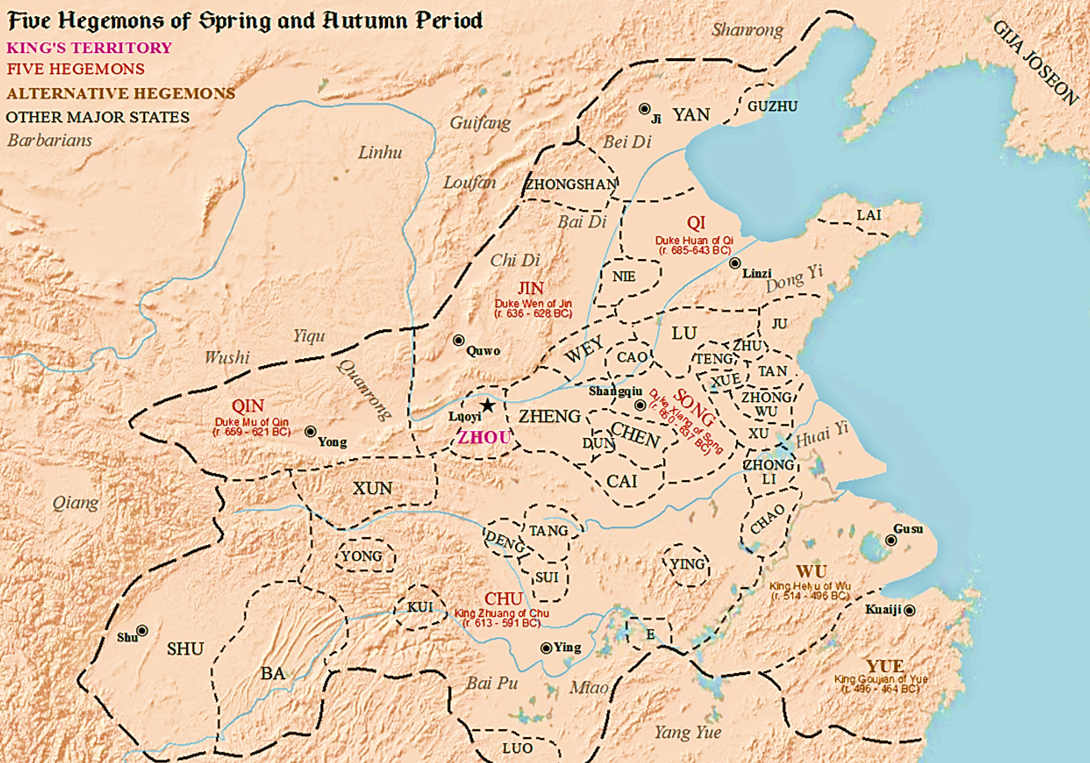|
Duke Gong Of Cao
Duke Gong of Cao (? – 618 BCE) () was the seventeenth ruler of the vassal State of Cao during the Chinese Spring and Autumn period (770 – 475 BCE). Born Ji Xiang (姬襄), he was the son of Duke Zhao of Cao. In 637 BCE, during the exile of Chong’er, son of Duke Xian of Jin, Duke Gong heard that Chong’er suffered from fused ribs in a parallel way that makes it look like one rib bone(which was considered as the sign of saints in ancient times) and wanted to see for himself. Chong’er caught Duke Gong spying on him whilst he bathed and described the Duke as a man of “unbelievable rudeness”. Zuo Zhuan, “The Death of Chong’er”《晉公子重耳之亡》 After Chong’er became Duke Wen of Jin and one of the Five Hegemons The Five Hegemons () refers to several especially powerful rulers of Chinese states of the Spring and Autumn period of Chinese history (770 to 476 BCE), sometimes alternatively referred to as the "Age of Hegemons". There are various lists of fi ... [...More Info...] [...Related Items...] OR: [Wikipedia] [Google] [Baidu] |
Cao (state)
The State of Cao () was a vassal state in China during the Zhou Dynasty (1046–221 BC). The state was founded sometime in the 11th century BC by Cao Shu Zhenduo (曹叔振鐸; d. 1053 BC), a son of King Wen of Zhou and younger brother of King Wu of Zhou. With its capital at Taoqiu (陶丘), the State of Cao covered roughly the area of modern-day Dingtao County, Shandong Province. It was located on the flat country of the North China Plain about 50 miles east of the point where the current course of the Yellow River changes from east to north-east. To the northwest was Wey, to the northeast Lu and to the southeast Song. History As a result of the Cao's relative weakness, later generations wrote few records on events concerning the state's history. The only major event recorded in the Records of the Grand Historian during the Western Zhou Dynasty (1046 – 770 BC) was in 826 BC when Count You of Cao was killed by his younger brother Count Dai of Cao.Sima Qian, ''Records of t ... [...More Info...] [...Related Items...] OR: [Wikipedia] [Google] [Baidu] |
Spring And Autumn Period
The Spring and Autumn period was a period in Chinese history from approximately 770 to 476 BC (or according to some authorities until 403 BC) which corresponds roughly to the first half of the Eastern Zhou period. The period's name derives from the ''Spring and Autumn Annals'', a chronicle of the state of Lu between 722 and 479 BCE, which tradition associates with Confucius (551–479 BCE). During this period, the Zhou royal authority over the various feudal states eroded as more and more dukes and marquesses obtained ''de facto'' regional autonomy, defying the king's court in Luoyi and waging wars amongst themselves. The gradual Partition of Jin, one of the most powerful states, marked the end of the Spring and Autumn period and the beginning of the Warring States period. Background In 771 BCE, a Quanrong invasion in coalition with the states of Zeng and Shen — the latter polity being the fief of the grandfather of the disinherited crown prince Yijiu — destroyed the ... [...More Info...] [...Related Items...] OR: [Wikipedia] [Google] [Baidu] |
Duke Zhao Of Cao
Duke is a male title either of a monarch ruling over a duchy, or of a member of royalty, or nobility. As rulers, dukes are ranked below emperors, kings, grand princes, grand dukes, and sovereign princes. As royalty or nobility, they are ranked below princess nobility and grand dukes. The title comes from French ''duc'', itself from the Latin ''dux'', 'leader', a term used in republican Rome to refer to a military commander without an official rank (particularly one of Germanic or Celtic origin), and later coming to mean the leading military commander of a province. In most countries, the word ''duchess'' is the female equivalent. Following the reforms of the emperor Diocletian (which separated the civilian and military administrations of the Roman provinces), a ''dux'' became the military commander in each province. The title ''dux'', Hellenised to ''doux'', survived in the Eastern Roman Empire where it continued in several contexts, signifying a rank equivalent to a captain o ... [...More Info...] [...Related Items...] OR: [Wikipedia] [Google] [Baidu] |
Duke Wen Of Jin
Duke Wen of Jin (697–628BC), born Chong'er (literally "Double Ears"), was a scion of the royal house of Jin during the Spring and Autumn Period of Chinese history. He famously endured a long period of exile from his realm before finally being restored to power (r.636–628BC) and rapidly leading Jin to hegemony over the other Chinese states of his time. He is a figure in numerous Chinese legends, including those about his loyal courtier Jie Zhitui, whose death is said to have inspired China's Cold Food and Qingming Festivals. Names "Duke Wen of Jin" is a posthumous name bestowed on him as part of his family's ancestral veneration. It literally means the "Cultured Duke of Jin". Duke Wen's given name was Chong'er. His clan name was Ji. Life Early life Prince Chong'er was born to Duke Xian of Jin in 697 BC. The '' Zuo Zhuan'' notes that "his ribs were all grown together," a sign of strength and leadership. Chong'er's half-brothers included Shensheng and Xiqi. While Shen ... [...More Info...] [...Related Items...] OR: [Wikipedia] [Google] [Baidu] |
Duke Xian Of Jin
Duke Xian of Jin (, died 651 BC), ancestral name Ji (姬), given name Guizhu (詭諸), was the nineteenth ruler of the State of Jin. He was also the ninth ruler of Jin in the Spring and Autumn period and the second duke of Jin. When his father, Duke Wu of Jin, died in 677 BC, Guizhu ascended the throne of Jin and became Duke Xian of Jin. He reigned for 26 years. He moved the capital from Quwo (曲沃) to Jiang (絳). He was named after a Rongdi tribe (戎狄族) leader Guizhu (詭諸) whom his father, Duke Wu of Jin, captured alive. During his reign, the State of Jin was one of the most powerful and largest states due to his conquests in many small neighboring states. He is also renowned for the slaughter and exile of many royal family members of Jin and for favoring one of his concubines named Li Ji. Rise to power When he ascended the throne, Duke Xian of Jin and the duke of Guo visited King Hui of Zhou and they were given rewards which resulted to the increase of their popula ... [...More Info...] [...Related Items...] OR: [Wikipedia] [Google] [Baidu] |
Five Hegemons
The Five Hegemons () refers to several especially powerful rulers of Chinese states of the Spring and Autumn period of Chinese history (770 to 476 BCE), sometimes alternatively referred to as the "Age of Hegemons". There are various lists of five rulers of those certain states which rose to power over the other states of this time period, states which were also formed during the period of dissolution of a once real and strong central state, namely the empire of the Zhou dynasty. The Hegemons mobilized the remnants of the Zhou empire, according to shared mutual political and martial interests. An especially prominent Hegemon was Duke Huan of Qi. Pronunciation and meaning In ancient Chinese, (Old Chinese: ; Pinyin: ) '' has a similar meaning and pronunciation to (Old Chinese: ; Pinyin: ), which means 'the eldest son in a family', or 'senator'. Both and can be translated as the 'Five Hegemons'. () literally means 'five', but in the context of ancient Chinese also has a more ge ... [...More Info...] [...Related Items...] OR: [Wikipedia] [Google] [Baidu] |
Duke Wen Of Cao
Duke is a male title either of a monarch ruling over a duchy, or of a member of royalty, or nobility. As rulers, dukes are ranked below emperors, kings, grand princes, grand dukes, and sovereign princes. As royalty or nobility, they are ranked below princess nobility and grand dukes. The title comes from French ''duc'', itself from the Latin ''dux'', 'leader', a term used in republican Rome to refer to a military commander without an official rank (particularly one of Germanic or Celtic origin), and later coming to mean the leading military commander of a province. In most countries, the word ''duchess'' is the female equivalent. Following the reforms of the emperor Diocletian (which separated the civilian and military administrations of the Roman provinces), a ''dux'' became the military commander in each province. The title ''dux'', Hellenised to ''doux'', survived in the Eastern Roman Empire where it continued in several contexts, signifying a rank equivalent to a captain o ... [...More Info...] [...Related Items...] OR: [Wikipedia] [Google] [Baidu] |


.jpg)